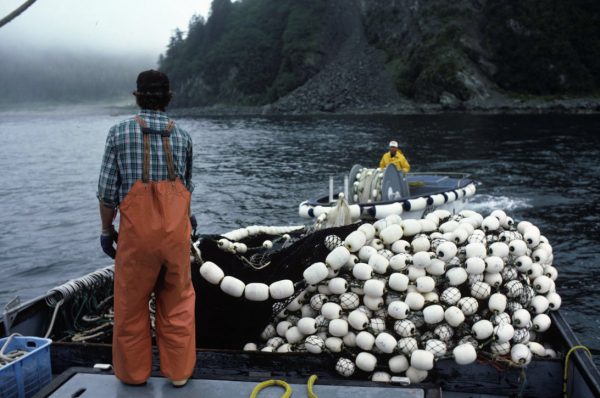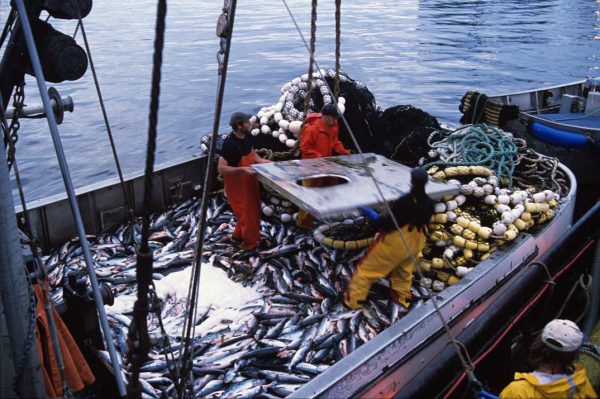Summit aims to train fishing's next generation
December 21, 2017
Paula Dobbyn
907-274-9698

Third-generation Bristol Bay fisherman Kristina Andrew didn’t sit still for most of the Alaska Young Fishermen’s Summit. The 30-year-old Dillingham resident paced the Dena’ina Center conference room, soothing her 1-year-old son, Kevin, strapped to her back.
Andrew took last summer off from drift gillnetting in Bristol Bay’s sockeye salmon fishery to care for Kevin. She’s itching to get back on the water next summer.
“My dad compares seeing fish coming over the roller to Christmas morning,” Andrew said. “I agree.”
Andrew was one of dozens of new and aspiring commercial fishermen gathered in Anchorage in early December for the summit. Organized by Alaska Sea Grant, a partnership between the University of Alaska Fairbanks and the National Oceanic and Atmospheric Administration, it aims to train the next generation of commercial fishermen to help turn the tide on Alaska’s graying fleet, where the average age of a boat captain is now 50.
Eighty-five participants formed the largest turnout among the seven summits held since 2007. About half the attendees this year were women.
Andrew is considering buying a boat of her own, but the finances involved are a bit intimidating. And skippering a vessel while nursing her son — and future babies — seems tricky.
“If anyone has the answers, I would love to hear from them,” Andrew said.
Balancing the pressures of commercial fishing with family life was the focus of one panel discussion at this year’s summit. Some key take-home messages emerged — for example, family comes first, no matter how exciting or profitable the fishing might be.
“When you’re home, be home,” said Steven Rhodes, a two-time summit attendee and fisherman from Sitka.

Don’t always talk about fishing. Turn off the phone and play with your kids, said several panelists, all experienced fishermen.
Other sessions included both nitty-gritty and big-picture details on how to navigate the Alaska fisheries regulatory process; how to successfully direct-market fish; how to maintain a vessel; and how to make a business plan, apply for loans, pay taxes and make a profit, or at least not go too far into the red or miss loan payments.
“I suspect it’ll happen to each of you at least once. Commercial fishing is all about risk management. Fish returns, for example, aren’t something you can control,” said Lea Klingert, president and chief executive of Alaska Commercial Fishing and Agriculture Bank.
Klingert, displaying spreadsheets with a variety of financial scenarios for fishermen, reassured the youthful audience that lenders like her are there to help if fishermen are serious about running a successful operation.
“We’re going to ask you for more financial information, and we’ll come up with a plan,” Klingert said.
However, if the borrower is off spending thousands of dollars on a Hawaiian vacation while behind on a loan, “we might have a different conversation,” Klingert said.
Aaron Hanson, 27, longlines and pot fishes for black cod, halibut and Pacific cod out of various ports in Alaska. He owns a Prince William Sound bowpicker and hopes to purchase a drift gillnet salmon permit to expand his fishing portfolio. The Cordova resident was a first-time participant at the summit and found the financial information on the business of fishing “extremely helpful.”
“I wish I would have done it when I was 20,” he said. “All the information I needed was there.”
Alaska’s congressional delegation sent videotaped messages of encouragement to the summit’s participants, and Gov. Bill Walker and Lt. Gov. Byron Mallott also stopped by.
Walker stressed the importance of commercial fishing, a multibillion-dollar industry, to Alaska’s economy.
“As the largest private employer in the state, it’s a big deal,” Walker said, adding that fishing helps diversify Alaska’s oil-dependent economy. “It’s a stabilizing factor.”
The governor said fish are a renewable resource and described himself as a “fish-first person.” When he travels to the Lower 48 and eats out in restaurants, if there’s salmon on the menu, “I cross-examine the waiter,” Walker said. “If it doesn’t say Alaska salmon, it just doesn’t work.”
Sunny Rice, an Alaska Sea Grant marine advisory agent in Petersburg who has organized the summit since its inception, was impressed with this year’s cohort of young fishermen. Not only was it the largest group to ever attend, but this year’s audience seemed particularly engaged with the material being presented and with each other.
“They’re just so jazzed to be around others who are doing the same thing,” Rice said.
The next Alaska Young Fishermen’s Summit will likely be held in early 2020 in Juneau.


